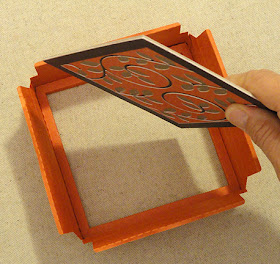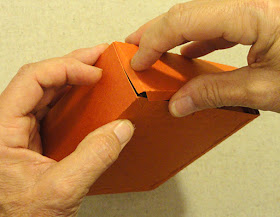Square box has engineered walls that create
a 1/4”
thick rim, with matching shorter lid
which fits on by means of interior corner
flanges.
Lid decoration is created by overlaying
the base square layers with vines base layer,
leaf and vines build up layer and contrast frame on top.
(Handle the delicate leaves layer with care.)
Lid rim is assembled, then overlay panel assembly
glued in placed underneath.
Box measures approx. 5x5x2.5 when closed.
ASSEMBLY: 1. Identify and cut the shapes:
A lid overlay base squares (3 for build up)
B lid overlay vine layer
C lid overlay leaf and vine layer
D lid overlay contrast frame
E lid side wall connected pair (2)
F base bottom
G base side wall front/back (2)
H base side wall side (2)
I base corner connector flange (4)
J & K lid/base accent shape strips (4 each;
see the NOTE in step 24 re: pattern matching)
L base underneath cover (conceals tab constr.)
M "weeded" interior square from D that
shows through as contrast vines
(for contrast otherwise, cut A top layer as contrast)
2. Prepare the overlay base build up by layering
and gluing the base squares together.
NOTE it will be helpful to use flat weight placed on top
of the layered shapes to keep them pressed during
drying to avoid warping or curling.
3. Layer the leaf and vines square on top of
the vines square, taking care to align precisely
the outer edges, and check also for edge alignment
of other interior vine edges, then glue layers together.
4. Position and attach the contrast frame square
on top of the previous overlay layers, taking care
to align the square outer edges precisely.
Press under a flat weight while liquid glue is drying.
5. If using the "weeded" frame square as contrast
behind the vines layer . . .
. . . position the square on the backside of
the layers assembly, with two of the corners
aligned exactly where the corner short vines' corner
is cut out, and attach in place.
Position and attach the decorative layers unit
on top of the built up base assembly from step 2.
Position and attach the decorative layers unit
on top of the built up base assembly from step 2.
6. Prepare the lid side wall/rim sections by folding
on the perforation lines as shown: bend all
lines back (mountain folds), except . . .
. . . bend the bottom
interior flanges forward (valley folds).
7. Prepare the upper fold sequence to form
the dimensional rim by rolling the narrow panels
under until . . .
. . . a square tube is formed as shown here.
Uncurl, apply glue to the face of the first panel,
then reposition and glue in place.
Uncurl, apply glue to the face of the first panel,
then reposition and glue in place.
NOTE: it is important to make sure that the rim
dries in a perpendicular (90 degree) angle to
the side walls. It may be helpful to use a square cut
object such as this wood block to square up the rim
being glued until it is sufficiently dried.
Repeat the gluing of all four rim sections.
8. Position the two rim/side wall sections side by side
with straight edge of left to overlap tabs of right,
inserting the shorted upper tab into the rim tube,
and glue in place to secure the first side seam.
Allow the glue to securely cure/dry.
9. Carefully form the connected walls into a square,
allowing the straight ends of two of the side rim tubes
to fit into the miter shaped tubes to which they are
adjacent. Bring the final corner edges together
and repeat the process in step 8 to complete
the final side seam.
NOTE: if possible apply a dab of adhesive near
the end of the square ends that will be overlapped
by the miter ends to help secure them in place.
Here is the lid frame complete through this step.
10. Carefully flex the side walls outward so that . . .
. . . adhesive can be applied along the underside
of the rim tubes.
Insert the overlay assembly into the backside of
the lid assembly so that the front frame surface . . .
. . . is directly behind the rim.
Push the overlay fully into place to attach behind
the rim, then apply pressure from behind until secure.
NOTE: it may be helpful to invert the lid on a flat
surface, then use flat objects along the edges
that can support other heavier objects above
the side walls to apply steady pressure until dried.
11. Apply glue to the backside of the square-ended
corners pair of interior side wall flanges,
then bend them inward to attach to
the overlay assembly backside.
Take care that the rim bottom edge is perpendicular
to the outer side walls as this step is completed.
After the first pair are attached, repeat
for the other pair, wrapping the corners over
to create the miter seam edge.
12. Prepare the 'F' marked front and back base wall
panels by bending the bottom tabs forward,
and bending back on all other perforation lines.
13. Prepare the two side panels in similar manner,
also bending the interior wall side tabs forward,
and the exterior wall side flanges back.
14. Join the wall sections into paired assemblies
which include one front and one side wall:
working on the interior wall portion, insert tabs
into corresponding slots, then . . .
. . . bend the tabs outward and glue in place.
15. Position the first paired walls unit next to
the slotted base bottom panel, aligning the squared
rim end (indicated by pointing finger) along the 'F'
marked edge.
(This frame shows the 'F' marking cut;
NOTE that the square cutouts have been
removed in the final cut file.)
16. Insert the tabs into the corresponding slots
of one wall, then bend to position the second wall
to insert tabs into slots.
Apply glue, then bend the tabs toward
the center of the square
to glue in place to underside of base square.
the center of the square
to glue in place to underside of base square.
NOTE that it will be helpful to place the assembly
base-side down on flat surface to allow finger pressure
to be applied along the wall seam until tabs are secure.
17. Repeat the process for the second wall assembly,
carefully inserting the bottom tabs into slots
one section at a time,
while at the same time inserting the side corner
tabs into slots. Apply glue to tabs,
bend into position, and attach all tabs in place.
18. Bend the 'F' walls back and around into
position, snug-ly tucking . . .
. . . the bottom flange around the base square,
and gluing in place. Apply pressure to keep
the square edge tucked into the flange/wall
angle, while also pressing along length of
flange to complete the attachment.
Repeat for the other 'F' panel.
bending forward along the vertical center perf line.
22. Test fit in the corner to determine the top
position of base wall, then apply glue to lower
portion that will attach to wall interior surface,
then re-position and hold in place until secure.
Repeat for all four corners.
straight edge aligned along lid rim edge,
centered side to side with offsets at sides and top.
Here is the completed box.
position, snug-ly tucking . . .
and gluing in place. Apply pressure to keep
the square edge tucked into the flange/wall
angle, while also pressing along length of
flange to complete the attachment.
Repeat for the other 'F' panel.
19. Prepare to bend the final two walls into place
by first applying a dab of glue at the square ends
of the rim face as shown. Then . . .
. . . bend the wall into place, applying glue to
side and bottom flanges, then tucking the side
flange under, overlapping the wall and applying
pressure along all seams as described at end
of step 18.
NOTE: the final cut design has the exterior side wall
flange tab attached to the 'F' marked
front or back sections.
20. Apply adhesive (dry adhesive tape style
recommended) to the underside edges and center
of the bottom 'cover' square, then position it
on bottom of base and attach in place securely.
21. Prepare the corner attachment flanges bybending forward along the vertical center perf line.
Also bend the top facing portion back, then . . .
. . . re-crease along center.22. Test fit in the corner to determine the top
position of base wall, then apply glue to lower
portion that will attach to wall interior surface,
then re-position and hold in place until secure.
Repeat for all four corners.
23. Place the lid onto the base by fitting so that
the corner flanges slip inside the lid rim walls.
24. Prepare to attach the optional side accent panels
by ensuring that the pattern-matched pair are used
together on the corresponding walls of closed box.
NOTE: if the pattern match is important, be sure to
position the two shapes exactly next to each other
on the cutting mat, prior to sending it to the die cutter.
Position the base strip centered on the base wall,
with upper square edge aligned with top of box wall,
and narrow offset margin on side and bottom.
Position the lid strip in similar manner, with lowerstraight edge aligned along lid rim edge,
centered side to side with offsets at sides and top.
Here is the completed box.

















































